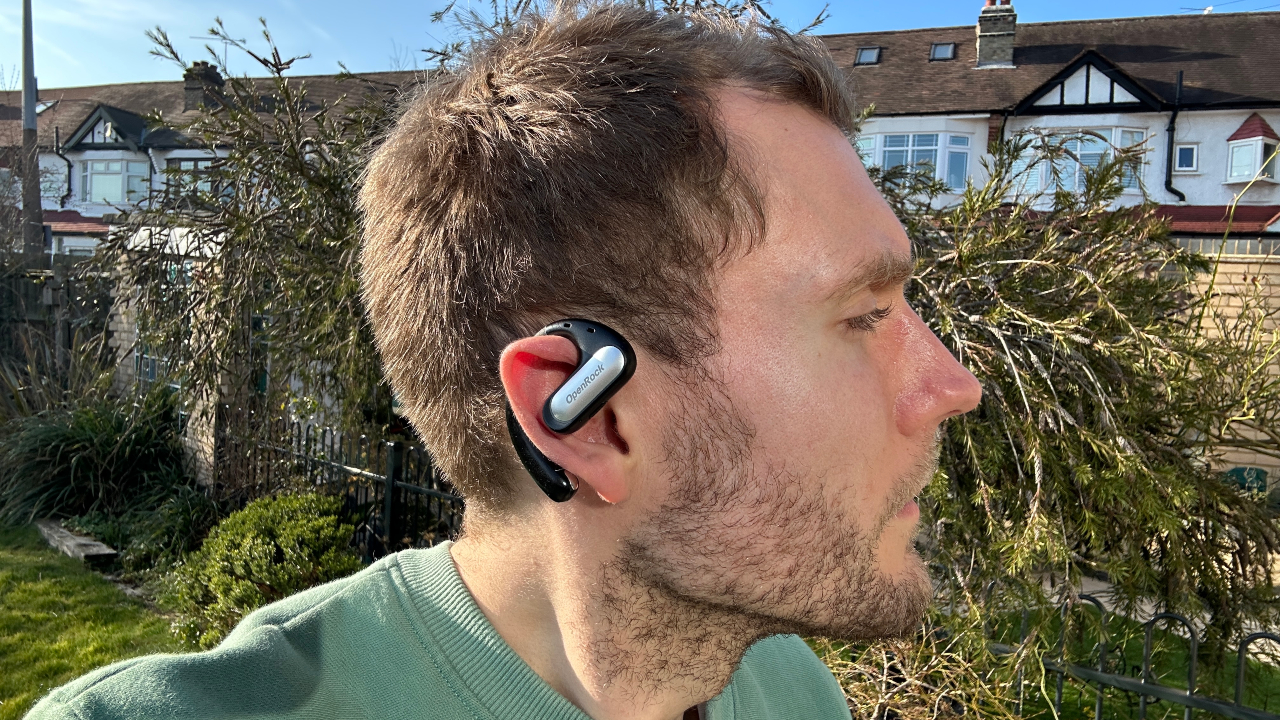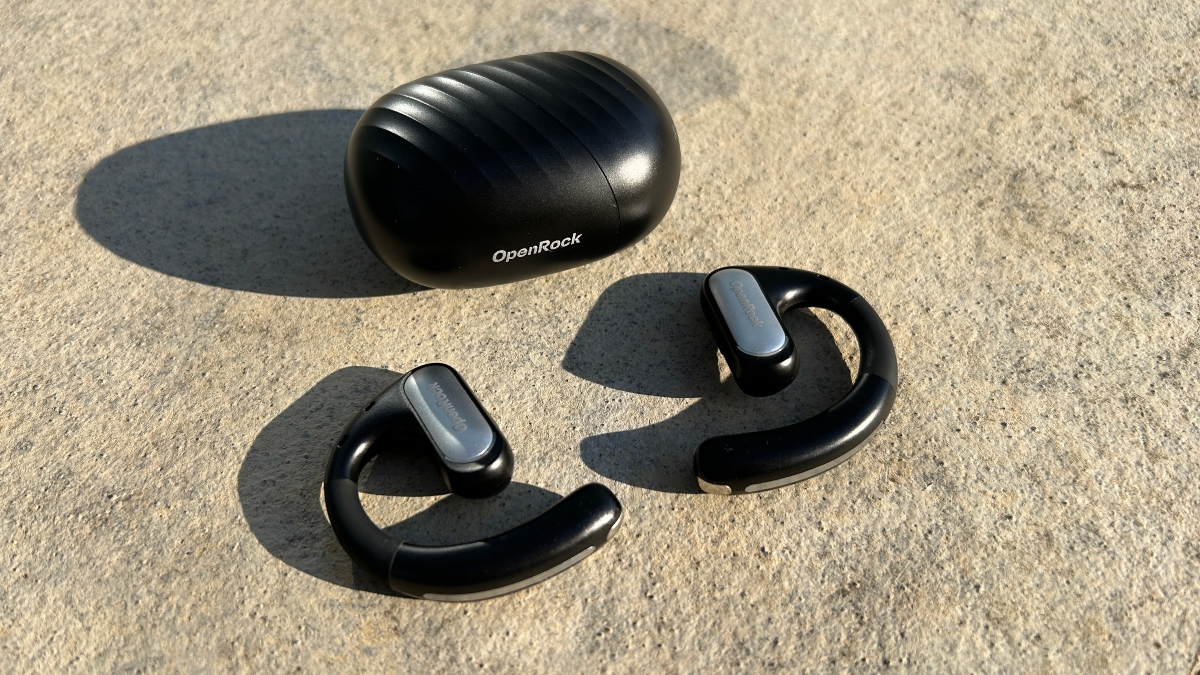Our Verdict
While the fit of the OpenRock Pro earbuds isn’t perfect, they are an excellent open option for those who want better sound quality than bone conduction headphones offer. The battery life is terrific and the earbuds are good value.
For
- Good sound for open buds
- Long battery life
- Cheaper than rivals
Against
- Fit can be uncomfortable
- Don’t sound as good as in-ear buds
You can trust Coach
The OpenRock Pro are open earbuds that aim to provide an awareness of your surroundings alongside solid sound quality, which is a tricky feat to achieve. They are a rival to other open buds, such as the Shokz Openrun, Sony LinkBuds and Oladance Open Ear headphones, and among the best workout headphones you can get, especially for running.
OneOdio OpenRock Pro Review: Price And Availability
The OneOdio OpenRock Pro launched in January 2023 and cost $109 in the US and £102 in the UK.
Design And Fit
The OpenRock Pro headphones have a hook design and sit on top of your ear, with a speaker resting near your ear canal rather than blocking it like an in-ear bud. This allows you to remain aware of your surroundings while listening to audio.
It’s a similar design to that of the Oladance Open Ear Headphones, but I found the fit of the OpenRock buds more intrusive. The hook shape doesn’t have much flexibility and it’s quite large and noticeable during exercise. It’s also hard to fit the headphones around glasses and they sometimes slipped out of position during runs, which moves the speaker away from the ideal position by your ear canal.

The fit isn’t disastrous, and I ran and worked out many times using the buds without them falling off, but they are less comfortable than the Oladance buds or any of Shokz’s range of ear-hook headphones. With a water resistance rating of IPX5, the OpenRock Pro earbuds will withstand the sweat or rain you encounter in your workouts, though they are not fully waterproof.
There is a multifunction button on each earbud that controls playback. This works well and is easy to use even during sweaty workouts, unlike the touch panels that have become more common on truly wireless headphones.
The OpenRock Pro headphones come with a large carry case that also charges them: with the headphones themselves lasting 19 hours, this brings the total battery life to 46 hours.
Sign up for workout ideas, training advice, reviews of the latest gear and more.
How I Tested These Headphones
I have used the Odio OpenRock Pro earbuds for several runs indoors and outdoors, plus a yoga session, one cycle and a couple of strength workouts. I’ve also used them away from my training to check the sound quality for general use. I have also tested the Shokz range of bone conduction headphones, and other open-ear options, including the Sony Linkbuds and Cleer Arc headphones.
Sound Quality

By design, open-ear headphones will struggle to match the sound quality and the bass of in-ear buds, but there have been improvements on this front and the OpenRock Pro headphones provide a consistently reliable sound powered by 16.2mm drivers.
Music is clear and never gets distorted when you ramp up the volume, which can go loud enough for almost all situations. When running or cycling by busy roads the sound is drowned a little, but not nearly as much as with bone conduction headphones.
Of the open headphones I’ve tested, I’d say only the Oladance buds are better than the OpenRock Pro for sound quality, but the Olandace headphones are more expensive. You can also adjust the EQ with the Oladance headphones, though this didn’t tend to make a huge difference in my experience.
In-ear headphones still offer more bass and better sound quality overall, but the OpenRock Pro earbuds deliver a solid performance during outdoor workouts. There is a little sound leakage when using them in quiet environments, which might draw ire from those around you.
Battery Life
With 19 hours of battery life on the headphones, plus another 27 in the case, the OpenRock Pro earbuds offer exceptional battery life, and if you’re just using them for workouts you can go more than a month without needing to plug the case in. The buds also have a quick-charge feature that gets you an hour of playback from five minutes in the case.
This battery life is above average for wireless headphones in general, and given that other open headphones, like the Oladance and Cleer buds, have cases that aren’t chargers, this is an area where the OpenRock headphones stand out.
Are The OneOdio OpenRock Pro Wireless OpenEar Air Conduction Earbuds Worth It?

If you get on with the fit and you don’t wear glasses during workouts – or have particularly small ears – I think you will find the OpenRock Pro headphones an excellent option if you want open buds.
I prefer the fit and sound of the Oladance headphones, but they are $179.99/£199.99. Even though the Oladance headphones are often in sales, the OpenRock buds are cheaper and their battery life is an upgrade on the Oladance, while there’s not much between the two on sound and fit.
Shokz’s bone conduction headphones offer greater awareness and a more comfortable fit, but are a downgrade in sound quality. The OpenRock Pro buds are reliable enough for sound that you can use them all the time, though you will get better sound from in-ear buds at the same price.

Nick Harris-Fry is a journalist who has been covering health and fitness since 2015. Nick is an avid runner, covering 70-110km a week, which gives him ample opportunity to test a wide range of running shoes and running gear. He is also the chief tester for fitness trackers and running watches, treadmills and exercise bikes, and workout headphones.

